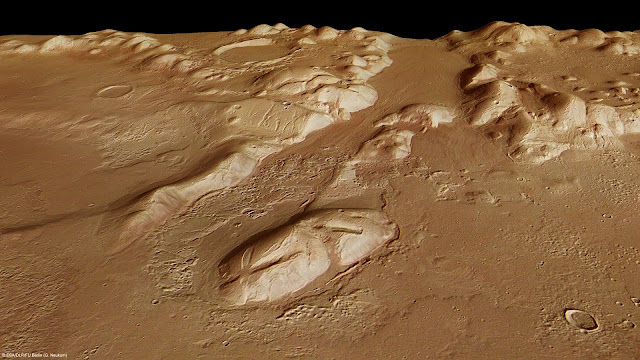MARS GLOBAL SURVEYOR (1996-2007)
Sidonia Mensae nd)
Planète Mars
Le relief
Cydonia Mensae, connu aussi sous le nom de "Le Visage de Mars" est un relief martien situé dans le quadrangle de Mare Acidalium. Il est à l'origine d'un exemple de paréidolie. Le 25 juillet 1976, au cours de sa 35e orbite, l'orbiteur Viking 1 survole Mars autour du 41° de latitude nord. C'est lors de ce passage qu'est pris le fameux cliché du « visage de Mars ». Si les scientifiques y voient un banal jeu d'ombres et lumière sur le relief, à l'époque, certains passionnés de vie extraterrestre ont cru y déceler une structure artificielle. Depuis, de nouvelles photos du visage prises par la sonde Mars Global Surveyor avec une résolution bien supérieure ont montré qu'il s'agit d'une colline érodée. Dans la zone de Cydonia à proximité du « visage », un peu plus au sud-ouest, il y a une autre colline ressemblant à une pyramide à cinq faces, mise en évidence par Vincent DiPietro et Gregory Molenaar et nommée en conséquence D&M. Les spéculations autour de ce « visage » atteignent un tel niveau que la NASA en fait une des cibles prioritaires de son nouvel orbiteur, Mars Global Surveyor. Jim Garvin, chef scientifique du programme d'exploration de Mars de la NASA, déclare « nous avons photographié le « visage » dès que nous avons pu en avoir un bon aperçub ». Ainsi, le 5 avril 1998, soit 22 ans après les images prises par Viking 1, Mars Global Surveyor photographie la région avec une résolution dix fois supérieure à celle de Viking 1, grâce son imageur Mars Orbiter Camera. Comme attendu, le cliché ne dévoile qu'un massif montagneux classique et aucun signe d'un éventuel visage.
La mission
Mars Global Surveyor (MGS) également désignée par son sigle MGS, est une mission spatiale développée par le centre JPL de la NASA qui a étudié de 1997 à 2006 l'atmosphère et la surface de la planète Mars en circulant sur une orbite héliosynchrone autour de celle-ci. La sonde spatiale devait répondre aux nombreuses interrogations soulevées par les données collectées dans le cadre du programme Viking lancé 20 ans auparavant portant sur l'histoire de la planète, la structure de sa surface et de son atmosphère ainsi que sur les processus dynamiques encore à l’œuvre. L'agence spatiale américaine lance la conception de Mars Global Surveyor en 1994 à la suite de l'échec de la mission martienne Mars Observer. MGS reprend les principaux objectifs de celle-ci, mais, afin de limiter son coût, la sonde spatiale réutilise les instruments et les équipements développés pour Mars Observer. Elle est construite et testée en un temps record puis lancée en novembre 1996. Pour se placer sur son orbite de travail autour de Mars, la sonde spatiale inaugure le recours à l'aérofreinage qui permet de réduire la quantité d'ergols transportée et donc d'abaisser les coûts. Le déploiement incomplet d'un panneau solaire rallonge la phase d'aérofreinage qui s'achève en février 1999, soit 15 mois après la date prévue. La phase de recueil des données scientifiques débute alors et se prolonge jusqu'en octobre 2006 établissant un nouveau record de longévité. Les découvertes réalisées grâce à la mission et les images spectaculaires prises par la caméra contribuent à renouveler l'intérêt des scientifiques mais également du grand public pour la planète Mars. L'altimètre laser de MGS dresse la première carte topographique de la planète mettant en évidence les différences spectaculaires entre les hémisphères nord et sud. Le spectromètre infrarouge TES découvre des régions où abonde l'hématite grise qui pourrait signaler la présence d'eau dans le passé et qui, à ce titre, fera l'objet d'investigations poussées par les missions spatiales suivantes. Le magnétomètre détecte un magnétisme rémanent présent dans la croute de certaines régions qui constitue sans doute le vestige d'un champ magnétique qui s'est éteint il y a 4 milliards d'années. Enfin, la caméra MOC fournit des images haute définition qui démontrent la complexité des paysages martiens, permettent de découvrir de nombreuses formations originales comme les traînées noires, les ravines associées potentiellement à la présence d'eau dans un passé lointain ou non, et plus généralement contribuent à reconstituer l'histoire de la planète.
______________________________________
2024 - Gravir les montagnes en peinture
Un blog de Francis Rousseau























